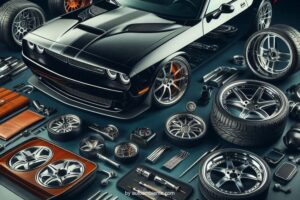Do you know about the Nash/Austin Metropolitan?
It’s a small car from Europe that sold only 9,300 units in Europe.
These cars are now very expensive, worth almost three times their original cost.
This shows how shady practices in the American muscle car era can lead to big changes in the industry.
This piece will look into the scandals of the muscle car’s golden age.
It will show how car companies used tricks to sell cars and hide their flaws.
We will explore everything from misleading power claims to the risks these cars pose.
Join us as we uncover the dark side of these iconic cars and their lasting effects on the world.
The Deceptive Marketing Tactics of Detroit’s Automotive Giants
In the past, American muscle cars’ golden era hid deceptive marketing. Detroit’s automotive giants used tricks.
They would overstate how powerful their cars were to make sales.
This meant their cars seemed stronger than they really were.
The Truth Behind Horsepower Claims and Performance Figures
This article will tell the real story behind these high claims.
It shows how Detroit’s car makers cared more about selling than being truthful.
Their goal was to keep their top spot in the muscle car market.
How Manufacturers Manipulated Data to Outshine Competitors
They played with the numbers and cheated in tests to look better.
This way, their cars appeared superior.
They did this to beat their rivals, despite the real numbers not being that great.
Factory Sabotage: The Untold Story of Maker Rivalries
The muscle car era saw big companies fiercely fighting each other.
They sometimes used sabotage to get ahead.
This darker side of the muscle car world shows how far companies would go to beat their rivals.
GM’s Secret War Against Ford’s Muscle Cars
General Motors (GM) is said to have led a hidden war against Ford.
They tried to stop Ford’s famous Mustang from being a threat. GM did things like messing with the manufacturing process and spreading lies.
Their cruel efforts highlight how tough the factory sabotage and maker rivalries were in the muscle car age.
Chrysler’s Covert Ops to Undermine Rivals
Chrysler also joined in the tough battle against its rivals.
They were accused of using covert ops to hurt other muscle cars.
Chrysler used many tactics, including making up stories and messing with competitors’ products.
This automotive sabotage added more fuel to the intense competition between the Detroit car makers. Everyone wanted to win in the muscle car market.
Muscle Cars and the Mob: Shady Dealings in the Auto Industry
The muscle car era wasn’t just about fast and powerful cars. It was also marked by the mob’s hand in the auto business.
There were claims of mobsters getting into the Big Three automakers in Detroit.
They allegedly used threats and illegal ways to control muscle car making and selling.
The link between the mob and muscle cars is both intriguing and worrying.
For example, the Mafia’s ties to New York’s waste disposal since the 1950s have been well-known.
Italy’s Camorra Mafia even controlled rubbish in Naples.
This history shows that organized crime has a long-standing interest in the auto world.
In the 1990s, actions were taken against mob members in charge of garbage hauling.
Then, in 2013, many were indicted for extortion in garbage hauling in New York City. This operation involved several crime families.
Although Mafia influence in New York’s waste industry has lessened, it’s still strong in places like Philadelphia and New Jersey.
The mob’s involvement reached beyond waste in the auto business, too.
There were rumors of mobsters influencing the Big Three.
They reportedly used scare tactics and unlawful actions. Their goal was to control the making and selling of famous muscle cars.
This could have harmed the reputation of the American auto scene.
The Scandal of Recycled Muscle Car Engines
The muscle car era was exciting, but it had a dark secret.
Recycled muscle car engines and reused powerplants came to light, weakening Detroit’s powerful image.
This article uncovers how Detroit’s automakers chose profits over quality. They put unknowing customers in danger.
How Detroit Reused and Remarketed Worn-Out Powerplants
In the muscle car world, deception was common. The scandal-hit hard when usages of worn-out engines surfaced.
Companies were caught recycling old engines to sell as new.
This hurt their cars’ performance and trustworthiness. Consumers started doubting the engines in their muscle cars and questioned their integrity.
This article shines a light on Detroit’s automakers and their deceitful ways.
They chose to prioritize quick gains, not customers’ long-term happiness and safety.
By recycling and reusing worn-out muscle car engines, these firms damaged the trust that launched the muscle car phenomenon.
Muscle Cars and the Rise of Automotive Icons
The muscle car era brought us not just powerful cars but iconic figures.
These people were behind and created classic American muscle cars. They became stars, known for the cult of personality around them.
Carroll Shelby stood out during this time.
He was a top designer and racing driver.
He helped create legendary muscle cars. His work on models like the Ford Mustang Shelby GT350 made him a muscle car icon.
The Cult of Personalities Behind Classic American Muscle
Shelby had peers like John DeLorean and Lee Iacocca who made major impacts.
DeLorean’s work on the Pontiac GTO marked a key moment for muscle cars. Iacocca, behind the Ford Mustang, also shaped the industry.
These powerful figures helped craft the muscle car world.
They weren’t just designers; they were stars too.
Their lives, achievements, and rivalry are part of muscle car history. This adds to the cult of personality around them and their classic American muscle cars.
Unsafe at Any Speed: The Dark Truth About Muscle Car Safety
Muscle cars were famous for their power but got into trouble for not being safe enough.
They were known to put speed and horsepower first, leaving safety and protection behind.
This piece will delve into why these fast cars often cut safety features to get more speed and power.
Prioritizing Power Over Protection: A Deadly Tradeoff
Companies sometimes choose to make the driving experience thrilling over keeping drivers and passengers safe.
This choice led to many accidents and even deaths. When the Malaise Era hit and the Clean Air Act of 1963 came, things changed.
This era focused on making cars efficient and less polluting.
But this came at the cost of some performance and safety features.
It was part of a big switch in the industry’s priorities.
Once American cars started to have less power, and catalytic converters became a thing, changes were needed.
For example, by 1971, cars had to meet new bumper standards to pass safety tests.
This meant cars should be safe in low-speed crashes, without costing a fortune to build.
But, the 1973 oil crisis happened, and gas prices went up. Muscle car fans found themselves in a tough spot.
They were dealing with cars that were not as powerful and were starting to look dull.
The Malaise Era was making cars that neither excited nor delivered the same performance.
This whole story had a major impact.
It changed how people saw these famous American cars.
The choices made then have lasted and continue to shape our views on muscle cars.
Muscle Cars
In 1966, the term “muscle car” was first used.
It described powerful two-door American sports cars.
They were built for exciting driving.
These cars with their unique style and strong engines quickly became loved by many.
To people, they symbolized the spirit of adventure on the road.
The start of muscle cars goes back to after World War II.
In 1949, General Motors began a race by putting a strong engine in a smaller, cheaper car. This made high performance accessible to more people.
Soon, cars like the Plymouth Road Runner and Dodge Super Bee became famous for their power and speed.
Muscle cars are famous for their big, strong engines, back-wheel drive, and being American made in the 1960s and 70s.
These include cars like the Ford Mustang and Chevrolet Camaro.
Even cars considered luxury, like the Mercury Cougar and Dodge Challenger, count if they have powerful setups.
Early on, these cars were called “supercars” in the U.S. A model like the 1957 Rambler Rebel stood out.
From 1960 to 1970, muscle cars and pony cars ruled the market with their power and style.
They brought a unique kind of excitement to car culture.
The Muscle Car Culture: Drag Racing and Street Legends
The muscle car era isn’t just about powerful vehicles.
It’s also about the lively culture they created, mainly in drag racing and illegal street racing.
These high-stakes car battles caught the public’s eye.
They helped make muscle cars symbols of power, speed, and American ingenuity.
The Wild World of Illegal Street Racing
Outside of legal drag racing, street racing was born. Enthusiasts met at hidden spots for intense grudge matches.
They would put their prized cars against each other. The loud V8 engines and burning rubber created an electrifying scene.
This drew everyone’s attention, from competitors to spectators.
Mythical Tales of Grudge Matches and Automotive Showdowns
The stories from these secret street racing events became legendary. They spoke of great automotive legends and what they did.
Tales of epic grudge matches between iconic muscle cars and their drivers spread widely.
This made the muscle car culture an essential part of American car history.
The Environmental Impact of Gas-Guzzling Muscle Cars
The muscle car era was a thrilling time for many in America.
It was, however, not great for the environment.
These cars had big, powerful gas-guzzling engines. This led to a lot of fuel being used and harmful emissions.
This was a big part of the energy crisis in the 1970s.
How Detroit’s Muscle Car Obsession Fueled the Energy Crisis
In Detroit, the focus was on making cars with lots of power. They used V8 engines that drank up gas fast. T
his meant more fuel was needed, and the nation’s resources were strained.
The muscle car craze played a part in the energy crisis.
These gas-guzzling engines were not good for the air.
They put a lot more carbon dioxide and toxins into the atmosphere. This made people start thinking about cleaner ways to travel.
It marked the beginning of a change in how the car industry looked at things.
Conclusion
The golden age of American muscle cars had its shadowy side.
Big car companies from Detroit tricked people with their ads. They also did harmful things behind closed doors.
This era was all about gaining power and being on top, even if that meant being dishonest.
Still, these cool muscle cars have left a big mark.
The excitement of watching drag races and strong rivalry made many people fall in love with these cars. They became an essential part of American culture.
But, their love for power and speed hurt our planet.
The huge engines of muscle cars played a part in an energy crisis during the 1970s.
This shows the car makers need to think about being good for the earth while making powerful cars.
After the muscle car time, a new era started, full of fresh ideas. We’ve learned from the bad things that happened before.
Moving ahead, it’s key for car companies to win back people’s trust.
They need to focus on making cars that are good for the planet, safe, and wanted by everyone.
The muscle car story is important, but the car world’s future depends on doing things differently.
They must mix the excitement of fast cars with the need to care for our world.




